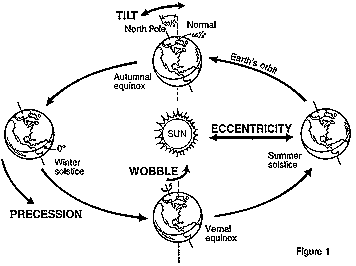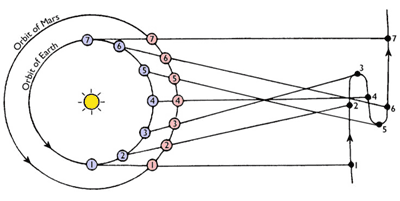Fig. 1 [9]
Newton's proof was groundbreaking. It demonstrated beyond a shadow of a doubt that the force of gravity was not only a very real thing, but also one that is universal, a force that applies to everything. In this way, Newton was able to cast into the fire, all the old notions of heavenly and earthly bodies being separate, as Earth must experience gravity in the same way as all the other planets [1]. Another more subtle reason for the significance of this proof, is that it was the spark to the great flame that was Newton's Principia. Formalizing the proof caused Newton to become borderline obsessed with the material and though Halley was only expecting a write up of the proof, he instead received a veritable goldmine of brilliant new discoveries [3]. These discoveries would eventually lead to the creation of Principia Newton's book containing all of his work on the laws of gravity. In other words, it was a book containing an entire field of physics that Newton birthed from this one idea [2]. In this way the initial spark of the square inverse force proof was far more important than just its direct corollaries.
,_title,_p._5,_color.jpg) The creation of Principia
was not exactly smooth sailing and very nearly never
occurred. Interestingly, the publication of the book had
far more to do with the personalities of two odd men [and one not-so
odd] than any mathematical proof. Newton was a surly, sulky recluse,
with far more angst built up than your average teenager; he
immaturely held grudges and would not take criticism. Robert Hooke
however, was the Joker to Newton's Batman; brash, brazen and with an
ego to boot, Hooke was a jock of academia if there ever was one [4].
However, unlike the relationship between the Joker and his masked
vigilante, Hooke had very little interest in Newton, though the
latter had quite the grudge against the former. Years before he had
begun working on Principia Newton
had sent a paper to the Royal Philosophical Society about his
thoughts on color and light. He received a reply containing nothing
but scathing criticism from none other than Robert Hooke, who at the
time was a member of the Society [2].
The creation of Principia
was not exactly smooth sailing and very nearly never
occurred. Interestingly, the publication of the book had
far more to do with the personalities of two odd men [and one not-so
odd] than any mathematical proof. Newton was a surly, sulky recluse,
with far more angst built up than your average teenager; he
immaturely held grudges and would not take criticism. Robert Hooke
however, was the Joker to Newton's Batman; brash, brazen and with an
ego to boot, Hooke was a jock of academia if there ever was one [4].
However, unlike the relationship between the Joker and his masked
vigilante, Hooke had very little interest in Newton, though the
latter had quite the grudge against the former. Years before he had
begun working on Principia Newton
had sent a paper to the Royal Philosophical Society about his
thoughts on color and light. He received a reply containing nothing
but scathing criticism from none other than Robert Hooke, who at the
time was a member of the Society [2]. After a time, Hooke forgot all about his words to Newton, then one fateful day he and two other members at the Royal Philosophical Society would start a conversation that would set up Newton for a permanent place in history. Robert Hooke, Edmond Halley and Christopher Wren sat discussing the inverse square force and how it may relate to universal gravitation, they all agreed that it would be incredible to prove that one induces the other and/or visa versa [1]. With his ego bursting at the seams, Hooke adamantly proclaimed that he would formalize a proof of the relation within two months. Amused and intrigued Wren proposed a gambit, a battle of wits between Hooke and Halley. Two months time they were give, to produce a proof of the square inverse force relation and the winner was to receive 40 shillings [2].
As Newton was the first to prove the relation, naturally Halley and Hooke failed. Hooke, embarrassed by his inability to create a proof levied excuse after excuse, claimed his occupation with other more pressing endeavors; Halley however, was truly intrigued. He was an accomplished mathematician himself and though blunt, Hooke was no slouch either. Halley wondered who could solve a problem that he and Hooke could not [2]. Here we return to the beginning of the story, Halley, bested by the problem, sought aid in the form of Isaac Newton. Halley had heard that Newton was an incredibly brilliant mathematician working at Cambridge and upon his arrival, Halley was not disappointed. He did however, leave empty handed, as Newton had not yet formally written up his proof [3].
When Halley finally received word from Newton, after many months of waiting, he got much more than he asked. Newton had sent Halley the groundwork for Principia, something Halley immediately recognized as an incredible breakthrough [3]. He fervently urged Newton to publish his work. Being the hermit that he was, Newton was hesitant to publish for fear of criticism, though he pressed on in the continuation of his work. This trend repeated countless times, Halley would plea Newton to publish, but Newton would refuse yet strangely keep on working [2]. As word of Newton's work began to spread within the circle of Halley's associates, Hooke was naturally one who caught wind. Perhaps jealous of the fact that he himself was unable to solve the problem, he began putting down Newton's work, inventing mistakes and eventually even claiming that the proof idea was his to begin with. Infuriated with his claims in addition to the age old grudge, Newton decided to give Hooke a well deserved back hand to the face, in the form of Principia, the completed publication of all his work on the laws of gravity [1].
It is also possible that Hooke may have
had more to do with the proof of the inverse-square law than it may
seem initially. It is acknowledged that Hooke sent a letter to Newton
about the possible inverse square relation of gravity, though it is
unclear whether Newton came up with the idea first. Furthermore, in
his Principia, Newton notes that the idea of the inverse
square relation was independently discovered by Hooke, Wren and
Halley, but this was little comfort to Hooke. [5]
His rivalry with Hooke was not the
greatest and most earthshaking conflict that Newton had been a part
of. Indeed his infamous controversy against Leibniz would result in
Continental mathematics speeding ahead of their once close rival
Britain [7]. Ultimately, the conflict arose when Newton and Leibniz
both independently discovered Calculus. At first they coexisted
happily, as Newton was not one to seek credit, however eventually,
accusations from third parties spurred the two men into a furious
debate. Leibniz desired the credit for his powerful notation,
notation that is still for the most part used today, while Newton
simply wanted to defend his honor as an honest man. Naturally,
Britain sided with Newton, not only because it was his homeland, but
also because all of the studies of calculus in Britain were
Newtonian, many British mathematicians could not even decipher work
done using Leibniz superior notation [6]. Unfortunately for the
Brits, Leibniz notation would prove to be so far ahead of Newton's,
that Continental mathematics grew exponentially, leaving Britain in
the dust [7].
Fig. 2 [12] Fig. 3 [11]
The events involving Newton, Leibniz,
Hooke, Halley and Wren dig up some interesting topics for discussion.
Who should receive more credit(?), someone who happens upon and sets
up the ground work for a new idea or someone who fully realises that
same idea; additionally, can it really be considered a discovery if
said discover-er refuses to release the information to the public. I
personally believe that the initial spark, the one who starts a new
idea and sets the foundation for it should receive far more praise
than one who simply fleshes out the details. I find it analogous to
the general proof method of popular unsolved equations in the
mathematics community. Often times, a well known mathematician will
provide a road map of sorts to the solution of a difficult problem;
they give a list of simpler ideas that if proven, give rise to the
one in question. This can be thought of as the first realization of
the idea. From there the rest is in some sense grunt work. Once the
plans have been laid out, hundreds of mathematicians can now tackle
these simpler problems, this being akin to the fleshing out of a
theory. Without the initial intuition, the fleshing out could never
occur, making it far more necessary, once the idea is out there,
eventually there will be those who will flesh it out. Furthermore,
with regards to who should claim credit for the discovery or
generation of a theory or idea, I believe the glory should go only to
those who share the knowledge. Glory, fame, credit and praise should
be given to those deserving and how can one who hides his knowledge
from all be deserving? They have not given anything, therein by the
property of reciprocation, they deserve nothing. The first individual
to publicly disclose the information should be credited, for they are
the ones who actually contribute to the general knowledge of the
public.
Of course, as with every opinion, there
are the extreme cases where credit should go to one who hides the
information out of necessity. A simple example of this is how Alan
Turing cracked the Enigma machine during WWII, but could not release
said information at the time without jeopardizing the war effort [8].
- http://en.wikipedia.org/wiki/Isaac_Newton
- http://faculty.wcas.northwestern.edu/~infocom/Ideas/newton.html
- http://www.pbs.org/wgbh/nova/newton/principia.html
- http://www.physics.org/interact/physics-evolution/text-only/03.html
- http://en.wikipedia.org/wiki/Inverse-square_law
- http://en.wikipedia.org/wiki/Leibniz%E2%80%93Newton_calculus_controversy
- Hyman, Anthony. Charles Babbage, Pioneer of the Computer. Princeton, NJ: Princeton UP, 1982. Print.
- http://en.wikipedia.org/wiki/Alan_Turing
9. http://hydrogen.physik.uni-wuppertal.de/hyperphysics/hyperphysics/hbase/forces/imgfor/isqg.gif
10. http://upload.wikimedia.org/wikipedia/commons/f/ff/Newton_- _Principia_%281687%29,_title,_p._5,_color.jpg
11. https://whatsnewwithnewton.files.wordpress.com/2008/10/dsc01537.jpg
12. https://classconnection.s3.amazonaws.com/33333/flashcards/644875/jpg/ftc1-leibniz-a.jpg






